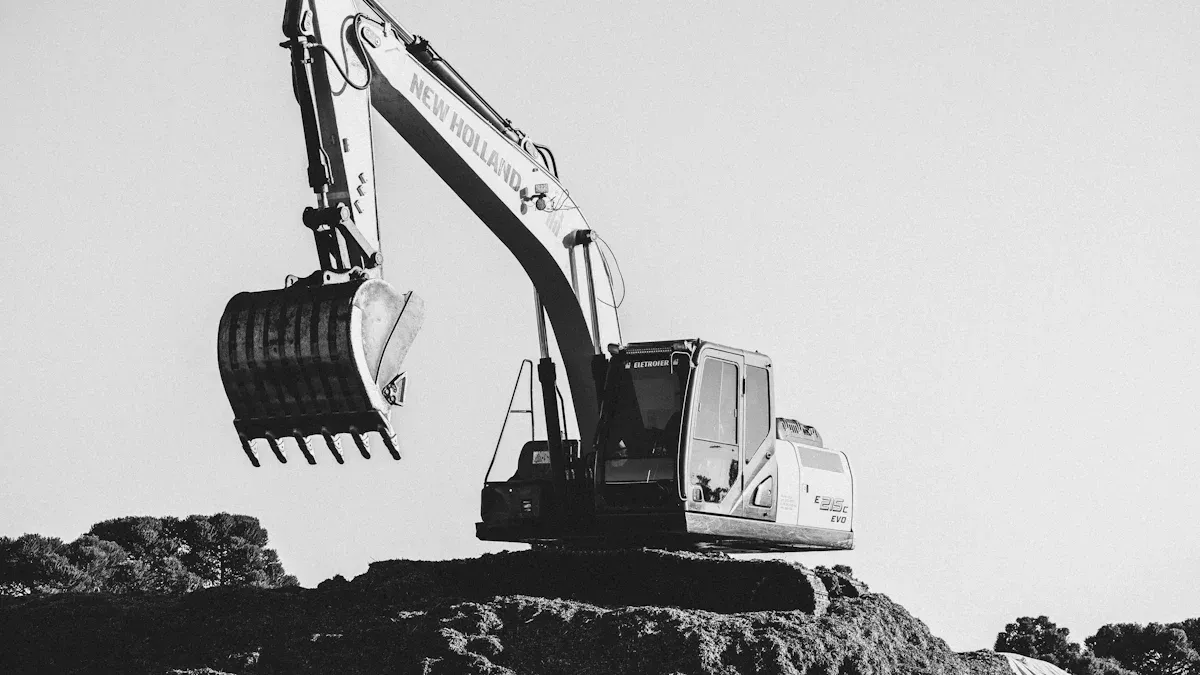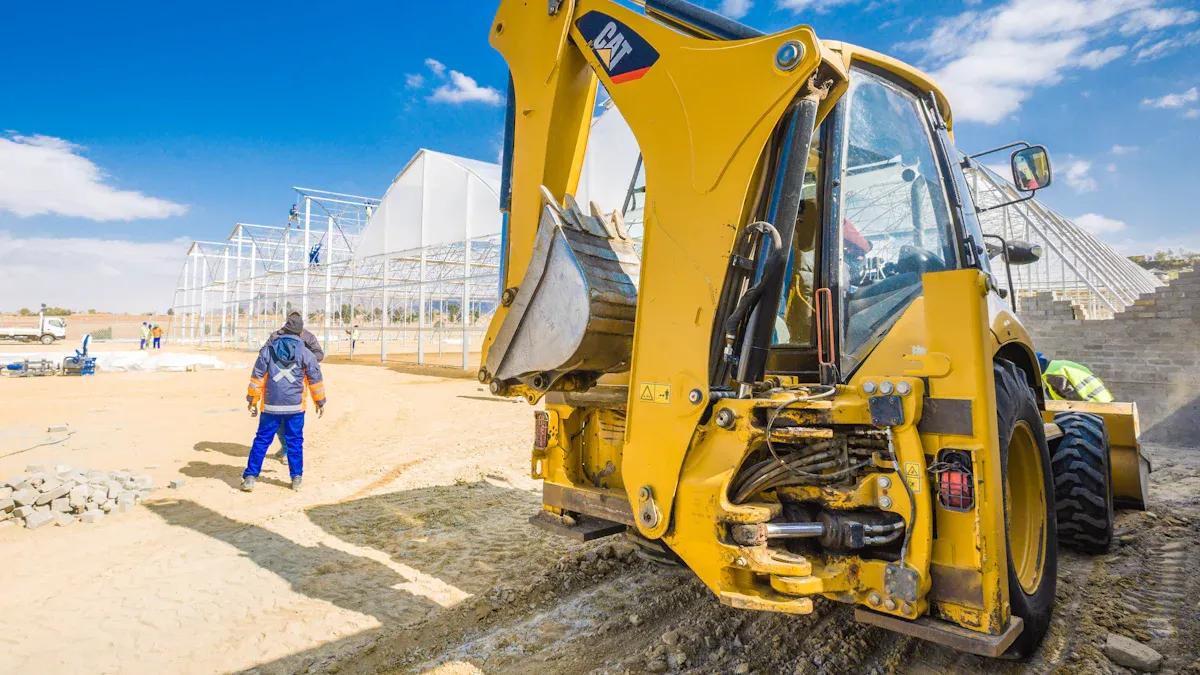
Maintaining the excavator bucket teeth, including Cat excavator bucket teeth, Komatsu excavator bucket teeth, and Esco excavator teeth, along with their bolts and adapters, ensures peak performance during operations. Proper care of the bucket teeth of the excavator reduces downtime and extends the life of crucial components. For instance, Caterpillar’s next-generation excavators demonstrate up to 20% lower maintenance costs when upkeep is prioritized. This approach also enhances fuel efficiency, directly impacting profitability.
Key Takeaways
- Taking care of Cat excavator bucket teeth helps them work better. It also saves money and makes parts last longer.
- Check the teeth every 50-100 hours of use for damage. Finding problems early avoids big repairs and sudden breakdowns.
- Use the right bolts and adapters for safety and good performance. Wrong parts can cause misalignment and wear out the machine faster.
Why Maintenance Matters
Benefits of Maintaining Cat Excavator Bucket Teeth
Regular maintenance of Cat excavator bucket teeth ensures consistent performance and operational efficiency. Well-maintained teeth improve digging precision, reduce stress on the excavator, and enhance fuel efficiency. This translates to lower operating costs and increased productivity. Additionally, routine care extends the lifespan of bucket teeth, bolts, and adapters, reducing the frequency of replacements. Operators also benefit from safer working conditions, as properly maintained components minimize the risk of sudden failures during heavy-duty tasks.
Maintenance also supports environmental sustainability. Efficiently functioning equipment consumes less fuel and emits fewer pollutants. For businesses, this not only aligns with eco-friendly practices but also meets regulatory standards. By prioritizing maintenance, companies can achieve long-term cost savings and operational reliability.
Consequences of Neglecting Maintenance
Neglecting maintenance can lead to significant operational challenges. Worn or damaged Cat excavator bucket teeth reduce digging efficiency, increasing fuel consumption and wear on the machine. Over time, this neglect can cause critical component failures, leading to costly repairs and unplanned downtime.
- Regular maintenance prevents expensive repairs and minimizes unexpected downtime.
- Neglecting care increases operational costs due to component failures.
- Early problem detection through maintenance avoids catastrophic breakdowns.
Ignoring maintenance also compromises safety. Loose bolts or misaligned adapters can cause accidents, endangering operators and nearby workers. Furthermore, neglected components are more prone to corrosion and structural damage, which shortens their lifespan. Businesses that overlook maintenance risk higher expenses, reduced productivity, and potential safety violations.
Inspection Best Practices

Identifying Wear and Damage on Cat Excavator Bucket Teeth
Regular inspection of Cat excavator bucket teeth is essential for maintaining optimal performance. Operators should look for visible signs of wear, such as rounded edges, cracks, or uneven surfaces. These issues can reduce digging efficiency and increase stress on the machine. A worn tooth often struggles to penetrate tough materials, leading to higher fuel consumption and slower operations.
To identify damage effectively, operators can follow these steps:
- Visual Inspection: Examine the teeth for cracks, chips, or excessive wear.
- Measurement: Compare the current tooth size to the original specifications. Significant size reduction indicates the need for replacement.
- Performance Monitoring: Pay attention to changes in digging performance. Reduced efficiency often signals wear or damage.
Tip: Conduct inspections after every 50-100 operating hours or whenever the excavator is used in abrasive environments. Early detection of wear prevents costly repairs and downtime.
Recognizing Bolt and Adapter Issues Early
Bolts and adapters play a critical role in securing Cat excavator bucket teeth. Loose or damaged bolts can lead to misalignment, which compromises digging accuracy and increases the risk of component failure. Similarly, worn adapters may cause instability, reducing the overall efficiency of the excavator.
Operators should check for the following signs during routine inspections:
- Loose Bolts: Tighten bolts immediately if they appear loose.
- Corrosion: Look for rust or discoloration, which weakens the structural integrity of bolts and adapters.
- Adapter Alignment: Ensure adapters are properly aligned with the bucket teeth. Misalignment can lead to uneven wear and reduced performance.
Note: Use only compatible bolts and adapters designed for Cat excavator bucket teeth. Non-compatible parts can cause premature wear and safety hazards.
By addressing these issues promptly, operators can extend the lifespan of their equipment and maintain consistent performance. Regular inspections not only improve efficiency but also enhance workplace safety.
Bolt Maintenance Tips
Correct Techniques for Tightening Bolts
Proper bolt tightening ensures the stability and efficiency of Cat excavator bucket teeth during operations. Operators should use calibrated torque wrenches to achieve the recommended torque levels specified by the manufacturer. Over-tightening can damage the bolts, while under-tightening may lead to loose connections.
To tighten bolts effectively, follow these steps:
- Clean the Threads: Remove dirt, debris, or rust from the bolt threads before tightening. This ensures a secure fit and prevents premature wear.
- Apply Lubrication: Use a high-quality lubricant to reduce friction and enhance the bolt’s lifespan.
- Follow Torque Specifications: Refer to the equipment manual for the correct torque values. Tighten bolts evenly and in a crisscross pattern to distribute pressure uniformly.
Tip: Regularly inspect tightened bolts after heavy-duty operations to ensure they remain secure. Loose bolts can compromise the performance of the excavator and lead to safety risks.
Guidelines for Replacing Worn Bolts
Replacing worn bolts is crucial for maintaining the integrity of Cat excavator bucket teeth. Operators should replace bolts showing signs of wear, corrosion, or deformation. Using damaged bolts can result in misalignment and reduced efficiency.
When replacing bolts, consider the following:
- Inspect Bolts Regularly: Check for visible damage, such as cracks, bends, or rust. Replace bolts immediately if any issues are detected.
- Use Genuine Parts: Always opt for bolts designed specifically for Cat excavator bucket teeth. Genuine parts ensure compatibility and durability.
- Dispose of Worn Bolts Properly: Avoid reusing damaged bolts, as they can compromise the equipment’s performance.
Note: Ningbo Digtech (YH) Machinery Co.,Ltd. offers high-quality replacement bolts that meet industry standards. Their products ensure reliable performance and extended component lifespan.
Ensuring Compatibility with Cat Excavator Bucket Teeth
Using compatible bolts is essential for maintaining the efficiency and safety of Cat excavator bucket teeth. Non-compatible bolts can cause misalignment, uneven wear, and potential equipment failure.
To ensure compatibility:
- Verify Specifications: Match the bolt size, thread type, and material with the requirements of Cat excavator bucket teeth.
- Consult Manufacturer Guidelines: Refer to the equipment manual or contact the manufacturer for compatibility recommendations.
- Purchase from Trusted Suppliers: Choose bolts from reputable suppliers like Ningbo Digtech (YH) Machinery Co.,Ltd. Their products are designed to meet the specific needs of Cat excavator bucket teeth.
Operators who prioritize compatibility reduce the risk of premature wear and enhance the overall performance of their excavators. Proper bolt selection also minimizes downtime and maintenance costs.
Adapter Care Guidelines

Cleaning and Lubrication for Adapters
Regular cleaning and lubrication of adapters ensure their optimal performance and longevity. Dirt, debris, and hardened materials often accumulate on adapters during operations. These contaminants can cause wear and reduce efficiency. Operators should clean adapters using a stiff brush or compressed air to remove debris effectively. For stubborn residues, a mild cleaning solution can be applied.
Lubrication minimizes friction between the adapter and other components. Applying a high-quality lubricant prevents excessive wear and ensures smooth operation. Operators should focus on the contact points where the adapter connects to the bucket teeth and bolts. Regular lubrication also reduces the risk of overheating during heavy-duty tasks.
Tip: Clean and lubricate adapters after every 100 operating hours or when working in abrasive environments.
Aligning Adapters for Maximum Efficiency
Proper alignment of adapters is critical for maintaining the efficiency of Cat excavator bucket teeth. Misaligned adapters can lead to uneven wear, reduced digging precision, and increased stress on the equipment. Operators should inspect the alignment during routine maintenance.
To align adapters correctly:
- Position the adapter flush with the bucket edge.
- Ensure the bolt holes align perfectly with the bucket teeth.
- Tighten bolts evenly to secure the adapter in place.
Accurate alignment enhances digging performance and extends the lifespan of all connected components.
Preventing Corrosion and Structural Damage
Corrosion weakens adapters and compromises their structural integrity. Operators should inspect adapters for rust or discoloration during maintenance. Applying an anti-corrosion spray or coating protects the metal surface from moisture and chemicals.
Storing equipment in a dry, covered area also prevents exposure to corrosive elements. For added protection, operators can use protective covers on adapters when the excavator is not in use. These practices help maintain the durability and reliability of the adapters.
Common Mistakes to Avoid
Skipping Regular Inspections of Cat Excavator Bucket Teeth
Regular inspections are essential for maintaining the efficiency and safety of Cat excavator bucket teeth. Operators who skip these inspections risk overlooking early signs of wear or damage, which can lead to decreased digging performance and higher fuel consumption. Heavy wear on teeth and cutting edges compromises the equipment’s ability to handle tough materials, reducing productivity.
Neglecting inspections also increases the likelihood of sudden component failures. This can result in costly repairs and unplanned downtime. Maintenance records often reveal that skipping inspections leads to issues such as:
- Reduced efficiency due to worn or damaged teeth.
- Increased stress on the excavator, causing premature wear on other components.
- Safety risks from weakened cutting edges or loose connections.
Routine checks help operators identify problems early, ensuring the excavator performs at its best.
Using Non-Compatible Bolts and Adapters
Using bolts and adapters that are not compatible with Cat excavator bucket teeth can cause significant problems. Non-compatible parts often fail to align correctly, leading to uneven wear and reduced digging precision. This misalignment increases stress on the bucket and other components, accelerating wear and tear.
Operators should always verify the specifications of bolts and adapters before installation. Choosing genuine parts designed for Cat excavator bucket teeth ensures proper fit and durability. Trusted suppliers like Ningbo Digtech (YH) Machinery Co.,Ltd. provide high-quality components that meet industry standards. Proper compatibility minimizes maintenance costs and enhances equipment reliability.
Ignoring Early Signs of Wear and Tear
Ignoring early signs of wear and tear on bucket teeth, bolts, or adapters can escalate minor issues into major problems. Cracks, chips, or corrosion often indicate that components are nearing the end of their lifespan. If left unaddressed, these issues can lead to misalignment, reduced efficiency, and even equipment failure.
Operators should act promptly when signs of wear appear. Replacing worn components early prevents further damage and ensures consistent performance. Regular maintenance not only extends the lifespan of Cat excavator bucket teeth but also reduces the risk of costly repairs and downtime.
Regular maintenance of Cat excavator bucket teeth, bolts, and adapters ensures optimal performance and reduces operational costs. Key practices include inspecting teeth for wear, checking bucket edges for cracks, and lubricating pins and bushings to prevent excessive wear. These steps enhance equipment longevity and reliability. Ningbo Digtech (YH) Machinery Co.,Ltd. provides high-quality replacement parts to support these efforts.
FAQ
How often should operators inspect Cat excavator bucket teeth?
Operators should inspect bucket teeth every 50-100 operating hours or after working in abrasive environments. Regular checks help identify wear early and prevent costly repairs.
Can non-compatible bolts damage Cat excavator bucket teeth?
Yes, non-compatible bolts can cause misalignment, uneven wear, and equipment failure. Always use bolts designed specifically for Cat excavator bucket teeth to ensure safety and efficiency.
What is the best way to prevent adapter corrosion?
Apply anti-corrosion spray, clean adapters regularly, and store equipment in a dry, covered area. These practices protect adapters from moisture and chemical damage.
Post time: May-22-2025